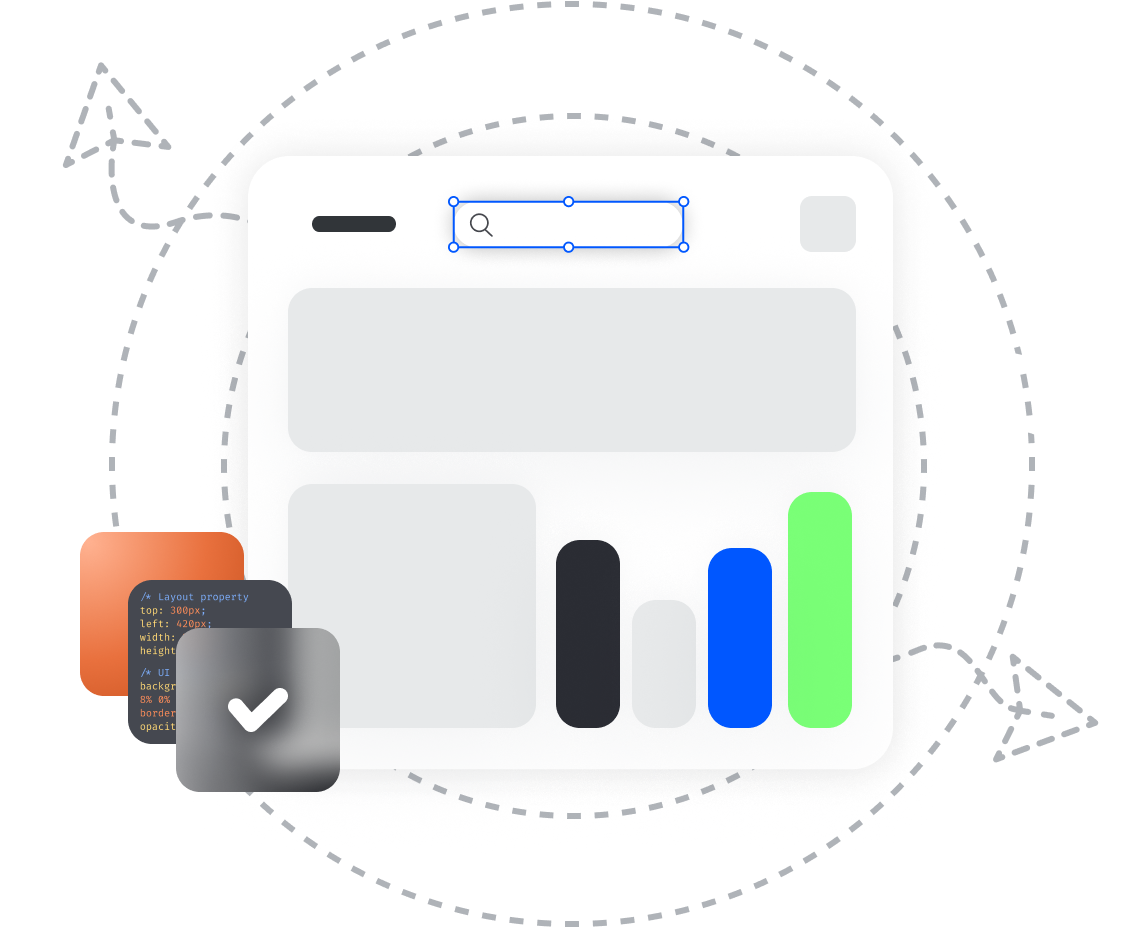All You Need To Know About Cross Platform App Development

Most businesses today have to switch to mobile devices to reach more target audiences. Therefore, it becomes important that applications are presented on all possible mobile platforms.
Native apps have proven to be fully interactive, intuitive, and fully compatible across all devices. However, it takes a lot of time and money to create two high-quality, flawless products. This is how the idea of building cross-platform mobile applications was born.
Cross-platform mobile apps are becoming more and more popular today. They provide access to different mobile platforms using the same codebase. Moreover, thanks to constant technical progress, they have reached the same level of quality as native applications, but at a significantly reduced development cost.
How Does It Work?
Software development can't be cheap, but that doesn't mean agencies aren't trying to optimize or cut costs. The very first and simplest solution was to create not two separate apps for iOS and Android, but one app for two systems. It is possible to create an application for two platforms using a common code and a common language. This solution allows you to save at least 30% of the development cost.
Thus, unlike native application development, multi platform solutions allow you to have one code base written in one programming language, which is then compiled for different platforms without any code changes for this.
When choosing the direction and method of developing an application, you need to proceed from the tasks and available resources.
Cross-platform application development has its pros and cons, which you need to know about and take into account in advance, before starting the project in development.

The advantages of cross-platform app development:
- It allows saving work resources: a single source code base saves you from having to hire several developers for each platform – for example, separately for iOS and Android – this is, of course, beneficial, since it results in less resource overhead for additional developers.
- It allows saving time and money: the development of an application for two platforms is carried out simultaneously since there is no need to separately write code for iOS and Android. This speeds up the work cycle and saves on budget. Technical support for a cross-platform application is also cheaper. Refinement of functions, fixing bugs – all changes are uploaded to two stores at once.
- It allows for easier customization of the application: it’s a normal practice when developing an application is to create an MVP first, and then finalize the functionality and technical support for the app. This is especially relevant with the update of the operating system, which causes bugs. Developing applications is much easier and cheaper if they have a common base.
- More than 70% of the codebase can be reused across different mobile platforms;
- Fast deployment of the application: there is no need to create different codebases, so deployment to the required platforms is faster;
- Cross-platform applications are suitable for users of all types and mobile devices, regardless of their operating system, which is significantly more cost-effective for a business than having the application on only one platform.
- There are fewer potential bugs. In cross-platform development, one team writes one code that will take over all platforms. Accordingly, such code potentially contains fewer errors. In native development, two teams, if we’re talking about iOS and Android, write two codes for each platform. Consequently, the number of discrepancies may be greater.
- The same appearance: on iOS and Android smartphones, the calendar, the transitions between screens, the search bar look differently, and in general, these operating systems have different logic of work. Cross-platform tools allow the application to look the same across all operating systems, which means that brand awareness increases.
The disadvantages of cross-platform app development:
- There is a lack of flexibility: development with a specific technology stack can’t provide the same flexibility in customizing an application as using technologies that are specific for each platform;
- There may be the low performance of products compared to native solutions;
- The interaction with application stores may be an issue: sometimes it takes longer to confirm a cross-platform application in the App Store than a native one;
- Cross-platform applications are almost always slower than native ones – additional modules are required to ensure their work.
Is Cross-Platform Development Suitable For Your Product?
The choice of technology depends on the objectives of the application.
If you need high performance, maximum responsiveness, and constant use of the system capabilities of a mobile device, a complex interface, and complicated animation for your future application, then native development will be the best option.
If your application needs to be developed as soon as possible, if it is not supposed to use all the computing capabilities of the device and it is important that the application interface looks the same on all devices, then cross-platform development is a suitable option.
Cross-platform apps do an excellent job of developing games and test cases. Modern games are created overwhelmingly on cross-platform technologies, which greatly speeds up development without sacrificing quality since special graphics frameworks are used.
Cross-Platform App Development Platforms And Tools
There are a lot of different frameworks for building cross-platform solutions. Let's take a closer look at the most promising ones.
React Native
React Native is an open-source framework owned by Facebook. It is the leader among the most well-known tools for building cross-platform mobile applications. This framework allows programmers to create native-like mobile apps.
With access to large built-in libraries, React Native provides smooth integration with other projects and simplifies testing.
However, to successfully work with React Native, you’ll need a team of skilled developers, because it’s a rather complex framework.
Xamarin
The framework was developed in 2011. It allows people who write in C# to get into mobile development. Thanks to the ability to combine cross-platform code with part of the native solutions, if necessary, Xamarin projects can provide the user with a completely native experience. Upon that, the codebase can remain practically unified.
Official support from Microsoft to this day is also one of the benefits of this solution. Thanks to the versatility, the cost of development for product launch and further support can be significantly reduced. Moreover, there are built-in testing tools. This will simplify monotonous manual testing on each platform (at least in part).
However, there are also some pitfalls. One of the most obvious: to work with the platform, programmers still need skills in working with native solutions, since Xamarin libraries often do not cover all the necessary functionality.
Flutter
Flutter is the fastest growing cross-platform development framework. It was introduced in 2017 by Google and managed to gain great popularity among cross-platform programmers.
Development using this framework is carried out in the rather experienced Dart language, the history of which began back in 2011. The language itself is very similar to Java. Switching to it is not particularly difficult for experienced Android developers. Flutter creates a single UI (using a declarative approach) for both platforms, and there will be no restrictions on customizing native UI components. The Flutter team has tried to make widgets indistinguishable from native components. Thanks to this, you can get a great user experience from the application.
Flutter has huge potential in the world of cross-platform development, and it can be safely chosen as a framework for mobile development. It provides a simple and fast development process as well as a large number of widgets. On the downside, this tool is used to build large-scale applications and does not ensure sufficient support for implementation-ready libraries.
Kotlin Multiplatform
The newest of the described solutions is Kotlin Multiplatform (KMP), developed by JetBrains (they are also the creators of the Kotlin language, which is the official language for Android development). In concept, this is not a framework for creating cross-platform applications, but an SDK that allows you to create modules with a single code base, which are subsequently connected to native applications.
The solution is very attractive due to the fact that most Android development is already carried out on Kotlin, and in terms of its syntax, the language is very similar to Swift. However, it may still take some time to learn. Don't expect any team to be able to move quickly to work with KMP.
The platform is perfect if you already have a working application. You can combine the parts and get a significant simplification of the support and development process. However, if you need to develop an application from scratch, it is better to choose other options.
To find the right decision for your business, you need to analyze the details of your project well. You can sign up for a free consultation at Yojji, where we’ll consider your ideas and desires and offer you a suitable solution. Having completed over 200 projects for our clients, we know our craft in cross-platform mobile development.

Yojji successfully delivered the project within schedule. They demonstrated excellent project management via weekly sprint demos and promptly made adjustments based on the client's feedback. Their responsiveness and collaborative attitude were key elements of their work.

5.0
Yojji was an instrumental part of the client’s team, working closely with them to achieve the product’s success. The team was very collaborative and timely, and their performance was amazing. Additionally, their resources were experienced, professional, and enjoyable to work with.

5.0
Yojii is impressive both in quality of development work as well as their commitment. Strong focus on delivery, highly technical personnel, flexible approach that allows for rapid development. Strong processes that allow for solid controls.

5.0
We’re very happy with the way that Yojji works, which is why we’ve spent so much money and engaged them for such a long time. We treat them as employees in regard to responsibilities and expectations, and they haven’t disappointed us.

5.0
As a company, we find Yojji to be excellent development partners - we cannot recommend them more highly and will be very happy to continue working with them in the future.

5.0
They are really nice people with excellent technical backgrounds.

5.0
We used Agile project management methodology and were in contact with the team and project manager daily.

5.0
They all had a super positive outlook and were dedicated to getting the work completed to a high standard.

5.0
Yojji has delivered an accessible product with thorough consideration for the client's requirements. Users have commented on the platform's user-friendliness and speed. Moreover, the team is easy to communicate with and provides frequent updates. Their development and design skills are impressive.

5.0
